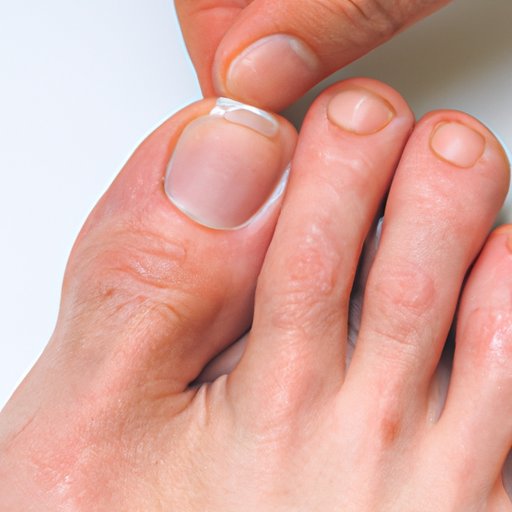
Introduction
If you’ve ever had an ingrown toenail, you know how uncomfortable and painful it can be. An ingrown toenail is a common condition that occurs when the edge of the nail grows into the skin, causing redness, swelling, and sometimes an infection. In this article, we’ll go over the causes of ingrown toenails, how to properly trim your toenails to prevent them, techniques for treating ingrown toenails at home, when to see a doctor, surgical solutions, and strategies for preventing future ingrown toenails.
Understanding the Causes of Ingrown Toenails
Some people are more prone to ingrown toenails than others. Factors that increase your risk of developing an ingrown toenail include:
- Having naturally curved toenails
- Wearing tight shoes or socks that put pressure on your toes
- Cutting your toenails too short or in a curved manner
- Having an injury to your toe
- Having poor foot hygiene
To prevent ingrown toenails, it’s important to wear properly fitted shoes that aren’t too tight or too loose. Shoes that are too tight can put pressure on your toes and cause the nail to grow into the skin. Additionally, you should trim your toenails straight across and avoid rounding the edges. Curving the nails encourages them to grow into the skin, causing an ingrown toenail.
How to Cut Your Toenails Properly
Trimming your toenails properly is essential for preventing ingrown toenails. Here’s how to do it:
- Fill a basin with warm water and soak your feet for 10 minutes. This will soften your nails, making them easier to trim.
- Pat your feet dry with a towel.
- Use a straight-edged toenail clipper to cut your nails straight across. Avoid rounding the edges or cutting them too short.
- Use a nail file to smooth any rough edges.
- Apply lotion to your feet to keep them moisturized.
In addition to proper trimming, it’s important to take care of your nails to prevent ingrown toenails. Keep your nails clean and dry, and wear shoes that fit well.
Techniques for Treating Ingrown Toenails at Home
If you have a mild to moderate case of an ingrown toenail, there are several home remedies you can try:
- Soak your foot in warm water and Epsom salt for 15-20 minutes, two to three times a day. The warm water will help reduce inflammation and the Epsom salt will help prevent infection.
- Apply an over-the-counter antibiotic ointment to the affected area to reduce the risk of infection.
- Gently lift the nail and place a small piece of cotton or dental floss under it to encourage it to grow above the skin.
- Avoid wearing tight shoes or high heels until the area has healed.
It’s important to note that these home remedies may not work for everyone, and in some cases, a doctor may need to intervene.
If the ingrown toenail is severe or if you notice signs of infection such as pus or redness spreading, see a doctor.
When to See a Doctor for Ingrown Toenails
It’s time to see a doctor if:
- The pain is severe and worsening
- The redness or swelling is getting worse
- You notice pus or signs of infection
- You have diabetes or another condition that affects circulation to your feet
A doctor may recommend that you take antibiotics or they may perform a minimally invasive procedure to remove the ingrown toenail.
Surgical Solutions for Ingrown Toenails
If you have a chronic or severe case of ingrown toenails, you may need to consider surgical options. Here are a few of the most common surgical treatments:
- Partial nail avulsion: The doctor removes the edge of the nail that is causing the problem, leaving the rest of the nail intact.
- Complete nail removal: The entire nail is removed, along with the nail bed. This is usually reserved for the most severe cases.
While surgical treatments do come with a small risk of complications, they are generally effective in resolving the problem. Your doctor will discuss the risks and benefits of each type of surgery with you to help you make an informed decision.
Preventing Future Ingrown Toenails
To prevent future ingrown toenails, follow these tips:
- Trim your toenails straight across.
- Avoid wearing tight or ill-fitting shoes.
- Wash and thoroughly dry your feet regularly.
- Avoid cutting your nails too short.
By taking good care of your feet, you can reduce your risk of developing ingrown toenails.
Conclusion
Ingrown toenails are a common problem that can occur for a variety of reasons. Luckily, there are many things you can do to prevent and treat ingrown toenails. By following the tips outlined in this article, you can keep your feet healthy and happy. Remember, if you have a severe ingrown toenail, it’s important to seek professional medical care to prevent complications.





